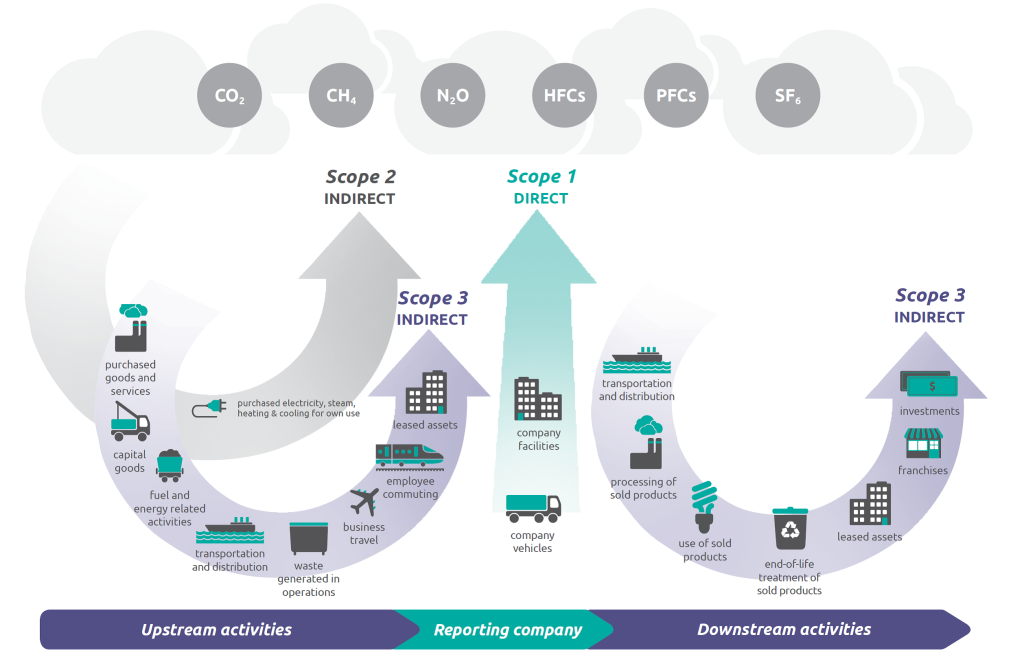Carbon Accounting and Energy Efficiency
In the era of climate urgency, achieving net-zero carbon emissions by 2050 is a global imperative. While carbon dioxide (CO2) is the primary focus, the broader spectrum of GHGs, including methane (CH4) and nitrous oxide (N2O), plays a significant role in the global warming potential (GWP) of emissions.
Understanding Carbon Footprint and Intensity
The carbon footprint, a measure of total GHG emissions, is expressed in carbon dioxide equivalent (CO2e), facilitating a unified assessment of environmental impact. To ensure fairness in comparison, especially for entities of varying sizes, carbon intensities—emissions normalized per unit of output or activity—are utilized, offering a more standardized metric for evaluation.
The Three Scopes of Emissions The Greenhouse Gas Protocol (GHGP) categorizes emissions into three scopes:
- Scope 1: Direct emissions from owned or controlled sources.
- Scope 2: Indirect emissions from the consumption of purchased energy.
- Scope 3: All other indirect emissions, from activities like material production and transportation.

Emission Inventories and Accounting
For accurate tracking and management, emissions are documented through inventories, detailing the volume and sources, and accounting practices that link these emissions to specific economic activities. This dual approach provides a holistic view of the environmental impact, guiding strategic decisions for reduction and mitigation.
Global Perspective on Carbon Emissions
At the European level, emissions are examined through three lenses: territorial, production, and consumption, each offering unique insights into the origin and impact of emissions, aiding in comprehensive policy formulation and action planning.
Methodologies for Quantitative Measurement
Prominent methodologies like the GHG Protocol, ISO 14064-1, and ADEME’s Bilan Carbone® offer frameworks for detailed GHG quantification and reporting, supporting organizations in transparently documenting and reducing their carbon footprint.
Principles of GHG Accounting
Adherence to principles such as relevance, completeness, consistency, transparency, and accuracy is vital in ensuring robust and reliable GHG accounting, essential for informed decision-making and stakeholder trust.
The Role of Policy and Regulation
Increasingly stringent regulations, including the EU taxonomy and SFDR, emphasize the importance of comprehensive carbon accounting. These regulations, along with initiatives like CRREM and GRESB, are shaping the landscape, making carbon strategy a critical element of risk management and sustainability efforts.
Energy Efficiency as a Carbon Reduction Strategy
Energy efficiency, particularly in the building sector, stands as a potent strategy for carbon reduction. Innovative technologies, sustainable building practices, and energy-efficient appliances contribute significantly to lowering GHG emissions, underscoring the sector’s pivotal role in the global energy transition.
Conclusion
Effective carbon accounting, combined with strategic energy efficiency initiatives, forms the cornerstone of the global journey towards net-zero emissions. By embracing rigorous accounting methodologies, adhering to regulatory standards, and prioritizing energy efficiency, stakeholders across the spectrum can make tangible progress in mitigating climate change and fostering a sustainable future.
Stakeholders at all levels must commit to continuous improvement in carbon accounting and energy efficiency practices, leveraging data and technology to drive impactful actions. Collaborative efforts, informed by accurate and comprehensive emissions data, are essential to achieving the ambitious goal of a net-zero future.








